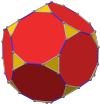Truncated_dodecahedron
Truncated dodecahedron
Archimedean solid with 32 faces
In geometry, the truncated dodecahedron is an Archimedean solid. It has 12 regular decagonal faces, 20 regular triangular faces, 60 vertices and 90 edges.
| Truncated dodecahedron | |
|---|---|
 (Click here for rotating model) | |
| Type | Archimedean solid Uniform polyhedron |
| Elements | F = 32, E = 90, V = 60 (χ = 2) |
| Faces by sides | 20{3}+12{10} |
| Conway notation | tD |
| Schläfli symbols | t{5,3} |
| t0,1{5,3} | |
| Wythoff symbol | 2 3 | 5 |
| Coxeter diagram | |
| Symmetry group | Ih, H3, [5,3], (*532), order 120 |
| Rotation group | I, [5,3]+, (532), order 60 |
| Dihedral angle | 10-10: 116.57° 3-10: 142.62° |
| References | U26, C29, W10 |
| Properties | Semiregular convex |
 Colored faces |
 3.10.10 (Vertex figure) |
 Triakis icosahedron (dual polyhedron) |
 Net |































